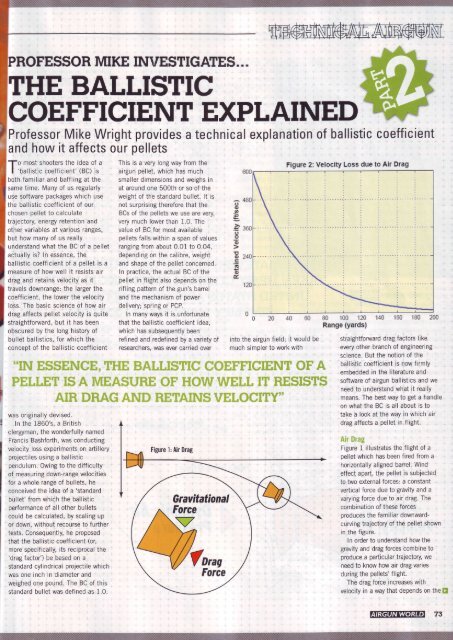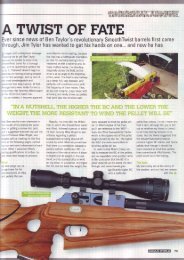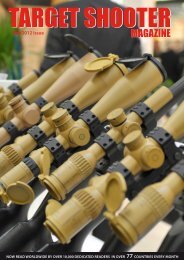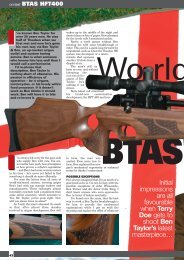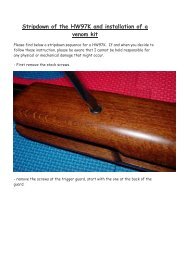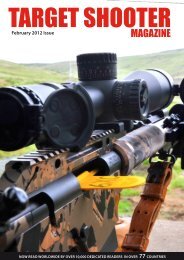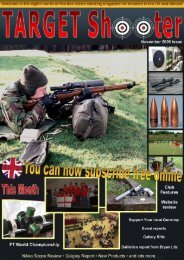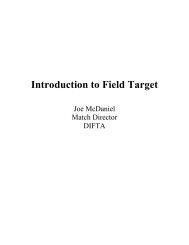THE BALLISTIC COEFFICIENT EXPLAINED
THE BALLISTIC COEFFICIENT EXPLAINED
THE BALLISTIC COEFFICIENT EXPLAINED
- No tags were found...
You also want an ePaper? Increase the reach of your titles
YUMPU automatically turns print PDFs into web optimized ePapers that Google loves.
ROFESSOR MIKE INVESTIGATES...<strong>THE</strong> <strong>BALLISTIC</strong><strong>COEFFICIENT</strong> <strong>EXPLAINED</strong>Professor Mike Wr,ight provides a technical explanation of ballistic coefficientand how it affects our pelletsfomost shooters the idea of a| 'ballistic coefficient'(BC) isboth familiar and baff ling at thesame time, Many of us regularlyuse software packages which usethe ballistic coefficient of ourchosen pellet to calculatetrajectory, energy retention andother variables at various ranges,but how many of us reallyunderstand what the BC of a pelletactually is? In essence, theballistic coefficient of a pellet is ameasure of how well it resists airdrag and retains velocity as ittravels downrange: the larger thecoefficient, the lower the velocityloss. The basic science of how airdrag affects pellet velocity is quitestraightforward, but it has beenobscured by the long history ofbullet ballistics, for which theconcept of the ballistic coeff icient* 4SSr.t{tuE"B **sTJqa¡E equ't**ffiffiffiffiffiffiffimffi-wffiffi ffiffitutuHffiwKffi ffiffiffiffiffiHffiffiffiffiww ffiffieffiffitutuffiw Kffie ffiffiffiffiffiffiffi ffiffi ffiffiwwffitutu Kw ffiffiffiffiffiwffi&ffiffi ffiffi&ffi -&ffiffi ffiffiw&Hffiffi wffituffimffiww--was originally devised.In the 1860's, a Britishclergyman, the wonderfully namedFrancis Bashforth, was conductingvelocity loss experiments on artilleryprojectiles using a ballisticpendulum. Owing to the difficultyof measuring down-range velocitiesfor a whole range of bullets, heconceived the idea'of a 'standardbullet' from which the ballisticperformance of all other bulletscould be calculated, by scaling upor down, without recourse to furthertests, Consequently, he proposedthat the ballistic coefficient (or,more specifically, its reciprocal the'drag factor') be based on astandard cyl indrical projectile whichwas one inch in diameter andweighed one pound. The BC of thisstandard bullet was defined as 1.0.This is a very long way from theairgun pellet, which has muchsmaller dimensions and weighs inat around one 500th or"so of theweight of the standard bullet. lt isnot surprising therefore that theBCs of the pellets we use are very,very much lower than 1.0. Thevalue of BC for most availablepellets falls within a span of valuesranging from about 0.01 to 0.04,depending on the calibre, weightand shape of the pellet concerned.In practice, the actual BC of thepellet in flight also depends on therifling pattern of the gun's barreland the mechanism of oowerdelivery; spring or PCP.In many ways it is unfortunatethat the ballistic coefficient idea,which has subsequently beenrefined and redefined by a variety ofresearchers, was ever carried overFigure l: Air DragGT0f1?0\into the airgun field; it would bemuch simpler to work withFigure 2: Velocity Loss due to Air Drag.::;\'' f:t.1'\1*.1x ü'"--.t' ¡,..,.:..;:\ \.\j'""':-r":-L{q1 t ' t ' 1 'ü ?ü 4S ñü SCI 10ü 1?S 140 1Sü lflüRange {yürdslstraightforward drag factors likeevery other branch of engineeringscience. But the notion of theballisticoefficientnow firmlyembedded in the literature andsoftwareairgun ballistics and weneed to understand what it reallymeans. The best way to get a handleon what the BC is all about is totake a look at the way in which airdrag affects a pellet in flight.&ilp ffiraRFigure 1 illustrates the flight of apellet which has been fired from ahorizontally aligned barrel. Windeffect apart, the pellet is subjectedto two external forces: a constantvertical force due to gravitY and avarying force due to air drag. Thecombination of these forcesoroduces the familiar downwardcurvingtrajectory of the pellet shownin the figure.ln order to understand how thegravity and drag forces combine toproduce a pafticular trajectory, weneed to know how air dragvariesduring the pellets' flight.The drag force increases withvelocity in a way that depends on the ffi7s
nature of the air flow over the pelletsurface. For the subsonic regime,with air flow velocitiesubstantiallybelow Mach 1 (i.e, for velocities upto about 950 fVsecond) that appliesto virtually all airgun pellets, the dragforce increases with the square of thevelocity of the pellet. Since thedeceleration of the pellet, or the 'airdrag', is proportional to this force,the following simple formula applies:Air Drag = Change in Velocity _ VetocityzTine Ballistic Ratngeof PelletThe constant in this for:mula, the'BallisticRange of the Pellet', is veryclosely related to the ballisticcoefficient, BC, as we shall see.In practical shooting we are, ofcourse, more interested in the wavthat pellet velocity varies withdistance rather than time and theair drag formula is better recast inthose terms:Change in Vetocity _ DistanceVelocity Ballistic Ranqeof Pellet0r o/o.Reduction lA0in Velocity =x DistanceBallistic Ranoeof Pellet'Note that, for a given distance,the percentage reduction in velocitydue to air drag is constant. This isthe essential pointo grasp aboutvelocity retention and it is the keyfact that determines the shape ofthe velocity/ distance curve. Toillustrate this point, let's look at anexample for a very poor pellet.Consider a pellet with a muzzlevelocity of 600 fVsec, which isslowe down by air dragto 492ft/sec at 10 yards range i.e. thepellet has lost 18 % of its velocityin 10 yards. Over the next 10 yardsit will lose another 18%, arriving átthe 20 yard mark with 403 ftlsec,At 30 yards, the velocity will be afurther 18% less at 337 ft/sec andso on, in similar fashion, as thepellet moves down range. Figure 2shows how air drag robs the pellet ofvelocity as it moves down range.HxpmlrerltimB Veimcüty H-*ssThis pattern of constant percentageloss over a given interval governsmany phenomena in the world aroundus. For example, it is the way thatradioactivity decays and is the basisof the carbon dating method for'ancient artefacts. lt is also the patternfor ring separation in a tree trunk andshows how the value of moneydeclines during a period of constantinflation. lt is called an exponentialdecay curve and the formula for italways contains the same numbernumber 3.1416, which is labelled aspi () because it comes up sofrequently. Using'e',,the velocityformula is:Muzzle VelocityVelocitY at Range'd'= --¡------,elBail¡stlc?ilgeThis is all very well, but we need toknow what the Ballistic Range of aparticular pellet is before we can doany calculations. By putting thevelocity formula into logarithmic form,we find that the following formulaemerges for the Ballistic Range:Ballistic Range =d,-tn(ffi¡,)'We can now use this value toestimate the velocity at anotherrange, say 35 yards:vetocity at 3s rards =frl=29}ntsThis velocity value is marked up ,Figure 2, where it can be seen thatlines up precisely with the 35 yardrange. The Ballistic Range formulprovides us with a simple methodoconverting two measured velocitietaken at two different ranges into ameasurement of the value of theBallistic Range.,But how does thisconstant, the Ballistic Range tie upwith the commonly used'' BallisticCoeff icient'?Tttm ffimHtistüe ffioeffisfrmmt arldffimtlistüc ffiangmIn order to understand the torturodefinition of the present:dayWhere'ln' denotes the naturallogarithm of the velocity ratioYou can find the 'ex' and 'ln'buttons on all scientifi calculators,including the one that I purchasedlast week for a pound from a well-**wmmffiffiewffiwffiffiK $vxffiffiffitu wffi ffiffiffiffiffiffiq"ffffiffitr&ffiffiffi Wffi ffi.Y ffiffifuffiffiffifu $'&fuTffiffi ffitrWffi&hfuffi ffiffi WffifffiMHWffiffi ffiWey-ffiffi &ffiffiKwpgffi AwwffiruTffiwffiffi wffiffiKMPfuHffiY ffiXEYffiWffiKK-ffi ffiffiMffifuWffi'-(2.7I83 to four decimal places)irrespective of the field of application.The equation for the velocity declineof our pellet with distance is:Velocity at Range'd' = #ffiBecause the number 2.7783'occurs over and over again in allforms of dynamic analysis, it is agiven the 'shorthand' label'e', where'e' is shorthand for'exoonentialconstant'. This is just like theknown discount chain. Thesefunctions are also built into a varietyof computer spread sheet packages.Let's take a look at how theseformulae apply to our example. Wewill first find the value of the BallisticRange. We know that the muzzlevelocity of 600 fVsec has fallen to403 fVsec at20 yards, so theBallistic Range will be given by:Battistic nanle = = Slyar¿sffiBallistic Coefficient, l th:ink it'shelpful to tr,ace a little bit of thehistory behind it.Although the notion of a balliscoefficient in its present form, asmeasure of bullet flight efficiencoriginated with the ReverendBashforth, it was Professor PeterGuthrie Tait, working in Cambridand Edinburgh, who published thefirst accurate trajectory formulaeithe 1860s, including the idea ofBallistic Range. Some 20 yearslater, the Krupp Company inGermany, made the first accuratemeasurements on the effect of airdrag on bulletrajectory in the1881. This was done by test f irinlarge flat-based, blunt-nosedbullets manufactured to a standadesign. Following the Kruppexperiments, military engineersRussia (Mayevski) and ltaly (Siacworked to derive a mathematicamodel to predict bullet trajectoryapparently unaware that ProfessTate had already broken the backof the problem (there was noGoogle in those daysl). TheMayevski modell was subsequentaken up by Colonel James Ingallof the United States Army, who74m


